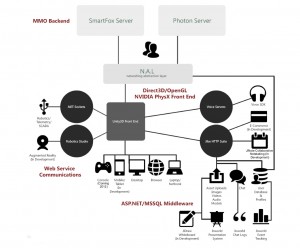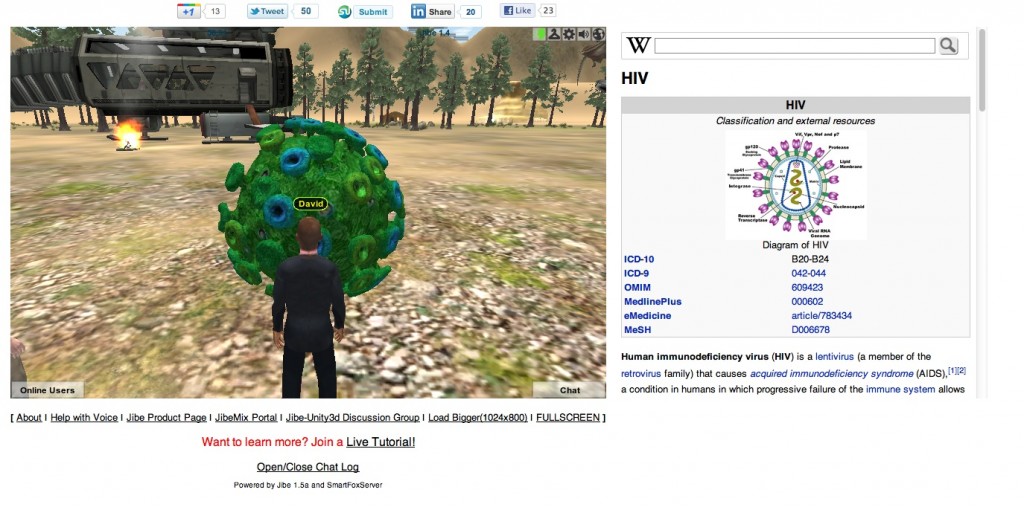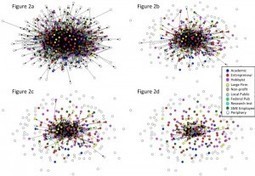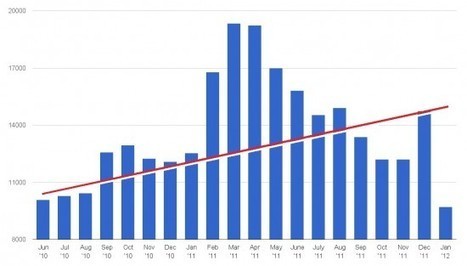While the nature of the firm has long been established as the dominant form of organizing for value creation, emergent forms of organizing such as the private-collective community model have recently gained attention from researchers and practitioners. Little is known about how such communities, where private goods from stakeholders are shared and freely distributed among a public collective, sustain themselves. The purpose of this research is to examine how the resources, stakeholders, and overarching network structure in which these are embedded influence the sustainability of the community. Using semi-structured interviews, archival data, and social network analysis, we explore these items in detail and provide initial findings from an ongoing research study of the OpenSim community. We conclude with future directions, expected contributions, and the limitations of this line of research.
Via nordicworlds.net
Academic Research Paper on OpenSim Community
Virtual reality contact lenses beam images directly into your eyes
Contact lenses which focus 3D screens directly into people’s eyeballs could be on sale as early as 2014, says U.S. company Innovega.
The tiny ‘screens’ sit directly on users’ eyeballs and work with a pair of lightweight glasses with a built-in translucent screen.
The experience is equivalent to a 240-inch television viewed at a distance of 10 feet, says Innovega’s CEO Steve Willey.
Via www.dailymail.co.uk
Virtual dummy makes designing clothes easy
Creating the pattern for a new dress design can be fiddly, so Amy Wibowo at the University of Tokyo, Japan, is using augmented reality to make it simpler.
Six ceiling-mounted cameras are trained on the dummy and on two tools held by the designer, one for creating surfaces and other for cutting them. The tools and the dummy both have markers, so the cameras can work out where in 3D space they are relative to each other. As the designer draws and works on and around the physical mannequin, this shows up on a virtual onscreen version.”The idea is to make it easy for people to design clothes,” says Wibowo. Usually you have to choose set patterns, which is limiting, she says. What’s particularly difficult is working out what 2D shapes are needed in order to achieve a particular 3D design.Her approach, called DressUp, gets round this by using “flattening” algorithms to work out the best shaped patterns to achieve the 3D design. Then you just print it out and cut around the patterns in the material of your choice, she says.
Via www.newscientist.com
Second Life’s greatest strengths are also its greatest weaknesses
If I were to make a list of the top three things that are responsible for Second Life being as great as it is – and that is exactly what I’m doing today – it would read equally well as a list of things that hold Second Life back.
Via dwellonit.taterunino.net
LEGO Universe is shuts up shop
The clock is chiming, and kids (and the young at heart) everywhere are asking for just a little more time with LEGO Universe. Unfortunately the struggling MMO has gotten no reprieve from the imaginary video game governor, and its servers will go offline tonight at midnight EST.
Via massively.joystiq.com
Litigating Trademark And Copyright Cases In The Metaverse | The Metropolitan Corporate Counsel
In Neal Stephenson’s 1992 science fiction novel, Snow Crash,[1] humans battle each other as avatars in the “Metaverse,†the collective product of online shared three‑dimensional space.[2] While Stephenson’s “Metaverse,†created by all virtual worlds as an augmented and enhanced physical reality and a physically persistent virtual space, does not exist today, millions of humans each year spend hours of their daily lives immersed in a three‑dimensional virtual world, fighting world wars, battling mythical creatures, living fantastic lives or running virtual businesses. Simply put, Stephenson’s science fiction view of future commerce in the Metaverse has become reality.As Stephenson envisioned, intellectual property is an important part of the virtual landscape. The current role of intellectual property in virtual reality demonstrates the promise and problematic nature of this new and different business world. This article will highlight some of the concerns and complexities that have been raised by recent cases of note regarding protecting one’s intellectual property in virtual worlds.[3]Recent cases, involving such diverse subjects as virtual art galleries,[4] sex toys,[5] stun guns,[6] strip clubs,[7] horses and bunnies,[8] and furniture,[9] highlight the legal issues and differences between virtual reality and real-life infringement cases. A review of these cases gives one insights with respect to protecting intellectual property assets in the world of avatars.
Via www.metrocorpcounsel.com
Podcast: “What Games Mean (And How They Mean It)”
Games are increasingly seen as a way to address human needs, from the intimate work of maintaining social relationships to the pragmatic benefits of games for learning, health, and social change. If we hope to design games that address these needs, we must understand how people create meaning with, through, and around games. How do specific game design decisions impact the way players think, feel, and behave? What kinds of imaginative and social affordances can games provide players? And what kinds of problems are most appropriate to solve with games in the first place? This talk explores the complex interaction between game design, user experience, and real-world problems through the lens of game-based research projects on discrimination, smoking, and history.
Via cms.mit.edu
Brief exploration of creativity in virtual world of Second Life
As popular as social networking portal Facebook is these days, no amount of apps and widgets can remove the limitation of Facebook being a website. There are limited ways in how Facebook users can interact with each other as opposed to individuals who reside in multiuser virtual environments like Second Life. Shared space, collaborative environment, and room for user created content all facilitate creativity at the individual and group level that for Ward and Sonneborn (2011), researchers at University of Alabama and Syracuse University, is worth taking a peek at in order to further our understanding about the nature of creativity.
Via www.examiner.com
Jibe platform walkthrough
I spent some time in recent weeks with John “Pathfinder” Lester, formerly of Linden Lab and now Director of Community Development at Reaction Grid. The purpose was for a walkthrough of the Jibe platform, which is a merger of Unity3D and other technologies to make a more comprehensive learning experience. I hooked up with John for a tour as I’m actively looking for a platform on which to base my upcoming research.
To say the walkthrough was a revelation was a bit of an understatement. I’d made the decision more than a year ago that I wouldn’t be using Second Life as the platform for my proposed simulation environment. My reasons for that are numerous but it basically came down to fine detail – I’ve seen a few demos of the Unity3D engine in action and for what I’m looking for it’s a markedly superior option, even factoring in Second Life’s potential development path over the coming 2-3 years. So, I was working under the assumption of a Unity3D only option – until I checked out Jibe.
So what is it? I’ll quote the official blurb as it summarises it pretty well:
The Jibe platform is an extensible architecture that uses a middleware abstraction layer to communicate with multiple backend systems (currently SmartFox & Photon) and frontends (currently Unity3D)
For the layperson, it means that aside from the 3D environment you’re interacting with, Jibe can bring in data from other systems. Whether it’s web content, 3D or other graphical content, it can be integrated into the viewing experience. Here’s a graphic demonstrating it:

(Click on the picture for full size)
For the educator / clinician wanting to create an immersive and realistic simulation, all this is essentially technical information that doesn’t need to be known. Which leads me to what impressed most with Jibe: the interface itself. Although I’d argue the overall browsing interface could do with some input from a designer (read: it’s not pretty), it does intrinsically work and removes a lot of the downsides research to date has shown about using Second Life or OpenSim on its own. Let’s use an example:

What you’re seeing here is my avatar standing in front of a model of a virus. In this case it’s the Human Immunodeficiency Virus (HIV). I can rotate the virus, check out all it’s aspects and when clicking on it, related information (in this case simple Wikipedia entry on HIV) opens in the same browser window I’m using. Obviously it doesn’t have to be Wikipedia – the sky’s the limit. Above the Unity window are a bunch of social media buttons allowing you to share information you’re interacting with.
If you refer to the Jibe graphic further above, remember that essentially anything can be bolted into the Jibe platform. If I were to use this platform I’d be looking at some sort of database connection that allowed me to have common clinical pathways viewed step by step as an avatar completes the task. You can also choose to have key content networked or local, meaning you could ‘phase’content for people progressing through the simulation at different paces. It’s all doable, it just takes time to set-up. As far as creating content, any pre-fab stuff from the Unity3D store can be pulled into Jibe.
If you’re interested in finding out more, this introduction to Jibe is useful. As far as pricing goes, check out the ReactionGrid Shop for options.
After spending around an hour being shown around Jibe, it really struck me how far advanced it was as a tool for educators compared to Second Life in particular. That statement is very dependent on the type of education occurring, but for more intricate work, the Unity3D interface combined with the use of well recognised standards for better interoperability, makes Jibe a very tasty option indeed.
Is OpenSim usage falling?
Today, Hamlet Au wrote a column suggesting that the OpenSim user base is shrinking — and used Hypergrid Business numbers to support his position.The short answer to his question is: No, OpenSim usage is not falling, and the numbers do not support this. In fact, it is growing quite well.The reason being — the numbers Au is citing aren’t the full numbers, not even for the top 40 largest grids. In particular, InWorldz has only released its active user numbers once, last month, when it was at 4,500 active users. And New World Grid, one of the largest grids, stopped reporting active user numbers this fall.Assuming that both have been growing steadily, in line with the growth on other grids — and in line with their region growth — that would show a very different picture.
Via www.hypergridbusiness.com
- « Previous Page
- 1
- …
- 5
- 6
- 7
- 8
- 9
- …
- 165
- Next Page »









Recent Comments